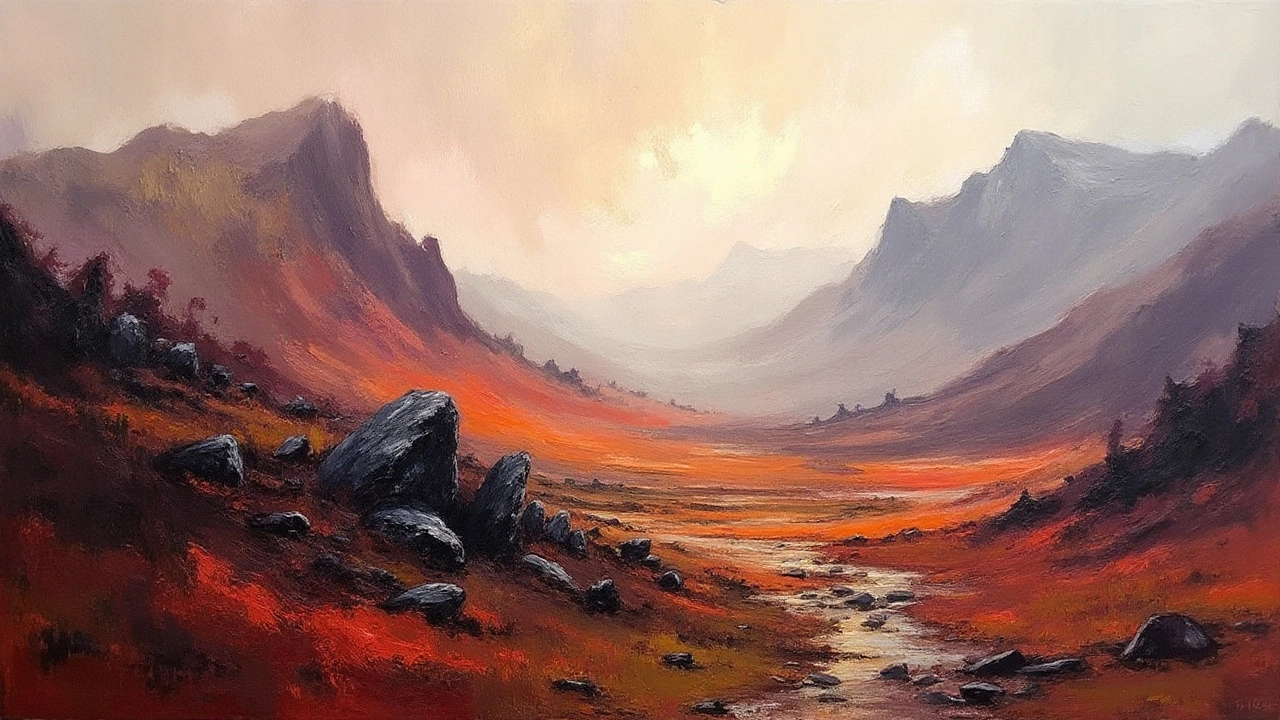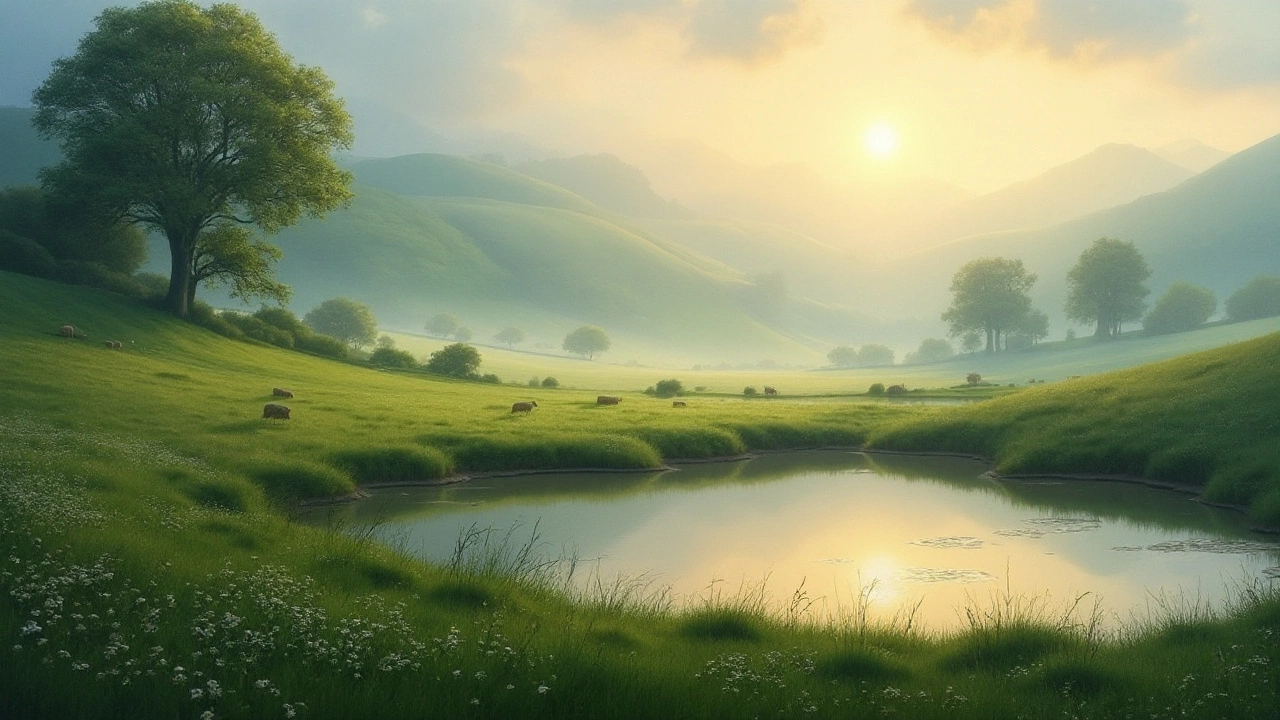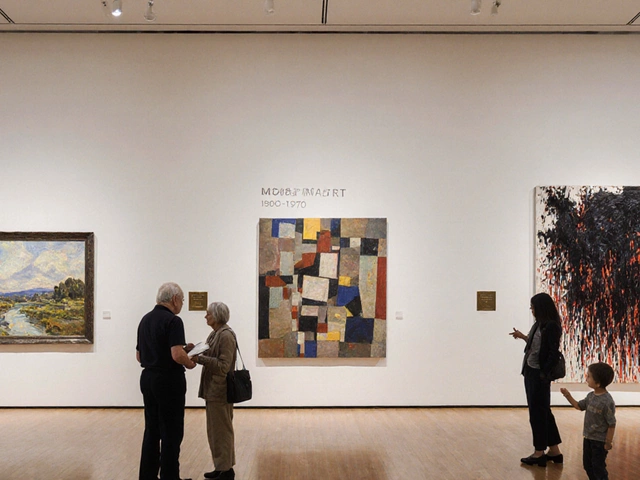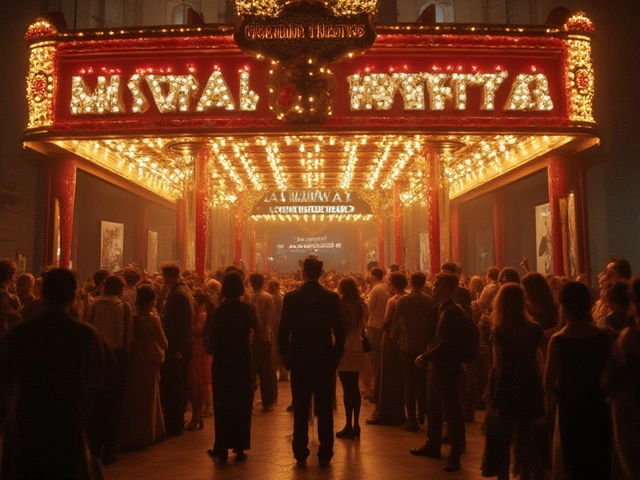Landscape art serves as a window into the natural world, offering artists a broad canvas to express and explore the beauty that surrounds them. As artists interpret the essence of a scene, they often find themselves drawn to one of three key styles: representational, impressionistic, and abstract landscapes. Each category provides a unique lens through which the splendor of nature is viewed and captured, allowing for endless creativity and innovation.
From the meticulous detail of representational art to the emotive strokes of impressionism, and the bold, expressive freedoms found in abstraction, landscape art can transport both the creator and the viewer to new realms of imagination. Whether you're an aspiring artist looking to hone your craft or an art lover curious to delve deeper into these styles, this exploration into the diverse world of landscape art will serve as a guide and inspiration.
- Understanding Representational Landscape Art
- Impressionistic Landscapes: Capturing the Essence
- The Allure of Abstract Landscapes
- Technical Tips for Aspiring Landscape Artists
- The Evolution of Landscape Art through History
- Incorporating Personal Emotion into Landscape Art
Understanding Representational Landscape Art
Representational landscape art stands as a tribute to the world as we see it, capturing the splendor of nature with unerring precision and detail. This genre seeks to mirror the natural world in its true form, offering viewers a window into realistic scenes crafted by the artist's adept hand. From the majestic peaks of mountain ranges to the soothing interplay of light and shadow in a serene forest, representational landscapes strive to maintain fidelity to the subject matter. This style requires a keen eye for detail and a meticulous approach to technique, as it relies on accurate color palettes, perspective, and composition to render lifelike images that echo the beauty found in nature itself. A famous example is the work of John Constable, whose ability to capture the English countryside with such veracity captivated viewers and made him a stalwart of representational art.
Within this genre, artists are tasked with emphasizing the beauty of specific places, documenting them precisely as they appear. This involves not only technical skill but also a comprehensive understanding of lighting, textures, and the inherent tonal values of colors in nature. Often, artists choose to work en plein air—a French term for painting outdoors—to immerse themselves entirely in the environment they wish to depict. This allows them to experience first-hand the shifting light, ephemeral skies, and the subtle nuances of the natural landscape. Renowned artist Asher Brown Durand once articulated the ethos of this genre beautifully, stating,
"Let us therefore consecrate ourselves to the natural grandeur, and draw from it those meditative themes by which our art may be ennobled."
Representational landscape art is more than mere replication; it is a dance between precision and artistic interpretation. Artists like Thomas Cole and Albert Bierstadt are lauded for their ability to balance accuracy with breathtaking vistas that evoke emotional and intellectual responses from viewers. Their works serve as historical records, preserving the beauty of untouched landscapes for generations to appreciate. Though digital photography now fulfills much of this documentary role, painting offers a richness and texture that a photograph cannot replicate. For aspirant landscape artists, mastering representational techniques can be a stepping stone toward greater artistic endeavors. By understanding and appreciating the intricacies of nature, artists open a dialogue between themselves and the viewer, inviting them to pause and reflect on the world around them.
The journey to creating compelling representational landscape art begins with practice and observation. Many artists advise starting with simple subjects to hone one's skills. Selecting a local park or a garden as a setting provides ample opportunity to explore textures, shades, and forms. Familiarity with the features of different landscapes, whether rolling hills or bustling seafronts, can contribute to a more expressive art piece. Through dedication and refined skill, representational landscape art offers a gratifying way to pay homage to the natural world's grandeur and intricacy. It's a tradition-rich genre that continues to capture hearts even today, reminding us all of the wonders that await just beyond our doors.
Impressionistic Landscapes: Capturing the Essence
The once-radical movement known as Impressionism broke with tradition to uncover the evocative beauty of landscapes in a completely new light. Emerging in the late 19th century, it sought to capture the fleeting nuances of natural scenes, eschewing meticulous detail in favor of expression and emotion. For painters within this genre, nature was not simply a subject to be painstakingly documented but a catalyst for invoking feeling through brush and canvas. This was an exciting time when artists were beginning to rebel against established norms, using broader strokes and vibrant colors to convey the scene's impression or mood, often stepping outside the boundaries of strict realism.
Impressionistic landscape artists believed that spontaneous, short brushstrokes could better represent scenes as the human eye perceived them—dynamic and ever-changing. This fluid technique allowed them to portray the shimmering light of a sunrise on water or the gentle dance of leaves in a summer breeze with a sense of movement and vitality. Authentically capturing how light and color change throughout the day, and different seasons, became paramount, transforming subjective perception into art. As Claude Monet once famously stated, each canvas was a unique quest to "show the juxtaposed colors that the sunlight produces."
"Impressionism is but a label, an expression of freedom from a preordained vision," noted art historian John Russell in his exploration of this illustrious movement.
Within the expansive realm of Impressionistic Landscapes, the interplay of light, atmosphere, and color is pivotal. The priority was to evoke the visceral experience of the moment. For artists like Monet, Renoir, and Pissarro, this style was more than technique—it was a philosophical departure from past artistic practices. By working en plein air, or outdoors, they embraced the raw unfiltered elements that they wished to convey on canvas. This afforded their works an immediacy and spontaneity that studio-bound works couldn't replicate.
The most successful impressionist landscapes communicate a sense of place in time as the audience is intimately drawn into the artist's vantage point. Consider Monet’s series of water lilies, where the delicate floating flora and mirrored reflections offer more than botanical study. They transport the observer into the serenity of Monet's garden, capturing atmospheres rather than objects. Impressionism can also be seen as an artistic response to scientific advancements of the era, particularly in optics and color theory, leading artists to exploit complementary colors for increased vibrancy.
Through today's lens, landscape art that adopts the impressionistic style continues to enthrall, reminding us of its origins rooted in freedom and a relentless curiosity to see the world beyond its literal representation. This legacy spurs new generations of artists toward innovative approaches, keeping alive the pioneering spirit of those who sought not just to depict the world, but to encapsulate experience and emotion within each scene. Such art remains a testament to the liberating power of seeing beyond what meets the eye and surrendering to the impression it leaves on the soul.

The Allure of Abstract Landscapes
Abstract landscapes have a unique power to draw viewers into a world where reality blends seamlessly with imagination. Unlike traditional forms that strive for approximate likeness, this style focuses on capturing the spirit or the underlying essence of the landscape. It becomes a dialogue between the seen and the unseen, where artists convey emotional resonance using experimental techniques. Often, colors are bold and unrestrained, and forms are simplified or even distorted to transcend beyond mere visual representation. This can turn a familiar scene into a new realm, inviting viewers to engage with their personal interpretations.
This type of landscape art can be incredibly liberating for the artist, allowing them to express personal emotions and ideas without the constraints of realistic detail. In abstract landscapes, a tree might be a swirl of colors, the sky might pulse with rhythmic lines, and a river could be a mosaic of geometric shapes. This freedom enables exploration of mood and emotion, fostering a connection between the viewer and the artist's inner world. An artist may emphasize a feeling of serenity through soft hues or express chaos with jagged forms and intense contrasts. Through these choices, each piece becomes a reflection of the artist's unique vision and an invitation to the viewer to explore their own emotional responses.
"Abstract art enables the artist to perceive beyond the tangible, to extract the infinite out of the finite. It is the emancipation of the mind. It is an explosion into unknown areas." - Arshile Gorky
To bolster creativity, artists might employ varied techniques such as layering, texture creation, and use of unconventional materials. Often, abstract landscapes engage one's senses on multiple levels, stirring emotions that connect deeply with personal experiences and memories without a need for literal representation. The scene depicted may not resemble any specific place, but rather evoke a universal feeling of belonging, nostalgia, or even unease, depending on the artist's intent.
A significant aspect of abstract landscapes is their ability to hold mystery. They allow viewers the freedom to find personal narratives within the artwork, each visit to the painting offering a new story or emotion. For collectors and admirers, these pieces often hold a timeless appeal, as their meaning may shift with each phase of life or change of perspective. This mutability keeps abstract landscapes perpetually fresh and engaging, ensuring their place in the esteemed world of art lovers and collectors alike. Whether for their aesthetic appeal or their ability to speak to the human condition in abstract ways, these landscapes remain a potent form of artistic expression.
Technical Tips for Aspiring Landscape Artists
Diving into the world of landscape art can be both thrilling and daunting for new artists eager to capture the soul of nature on canvas. Whether your passion leans towards the crisp lines of representational landscapes or the freeform expression of abstract forms, mastering basic techniques can elevate your artistic creations significantly. One of the initial steps involves selecting the right materials, including brushes, canvases, and, of course, paints. The quality of these items can dramatically impact your work. For instance, acrylics dry faster and are excellent for beginners, while oils offer a richness in tones perfect for those wanting to blend and layer.
As you start your journey, consider studying the methods utilized by esteemed painters in history. The use of color and light can transform an ordinary scene into a breathtaking masterpiece. The legendary Joseph Mallord William Turner, known for his formidable landscapes bursting with color and light, once remarked, "It is only when we are no longer fearful that we begin to create." Taking a cue from Turner, embracing a daring approach to color can lead to unexpected yet delightful results.
Another aspect to pay attention to is composition. Understanding perspective is key to crafting a piece that draws the viewers' eye across the canvas. Incorporate elements like leading lines—paths or rows of trees—that guide the viewer into the piece. Moreover, attempt to create depth by reducing detail and intensity of color in the background. It’s fascinating how subtle changes in perspective can imbue a piece with motion and life.
Furthermore, practice sketching your intended landscapes. This allows an artist to capture fleeting details that can often vanish when beginning the painting process. Thumbnail sketches are potent tools for playing with different arrangements and testing which perspectives elicit the emotive responses desired. As you gain confidence, these preliminary drawings become blueprints for more complex compositions.
Also, don't shy away from the technology available today. Digital tools can offer unique benefits for planning and experimentation. Many artists find software that allows layering and adjusting various elements an invaluable component of their creative toolkit. Whether it’s trying out different color schemes or simulating how natural light might shift across your piece, these digital aids can offer new insights and possibilities.
Finally, always allow room for personal intuition and creativity to flourish. While technical skills lay the groundwork, it is often the moments of improvisation that turn a good piece into a great one. Keep pushing boundaries and let your love for art inspire every stroke of your brush. Remember, art is a journey, not a destination. Enjoy each creation, learn from the process, and watch your skill evolve with each landscape you create.

The Evolution of Landscape Art through History
From the earliest depictions of nature etched onto cave walls by prehistoric artists to the brilliantly colored canvases of the 20th century, landscape art has evolved dramatically, reflecting both the changing world and humanity's shifting perceptions of it. Ancient civilizations like the Egyptians and Greeks integrated landscape elements into their art primarily as backdrops for mythological and religious narratives. However, it wasn't until the Renaissance that landscapes began to flourish as subjects in their own right. Artists like Leonardo da Vinci explored nature's intricate details, laying the groundwork for later traditions.
During the 17th century, the Dutch Golden Age heralded a profound transformation in landscape art. Artists such as Jacob van Ruisdael began to portray everyday pastoral scenes, rich with that nation's unique light and water-infused vistas. This period marked the emergence of representational landscapes, capturing nature with a precision that mirrored the burgeoning scientific and exploratory spirit of the time. An interesting fact is that these artists often demonstrated meticulous attention to detail, with paintings so realistic they served as early cartographic resources.
As the Industrial Revolution swept across Europe, the 19th century introduced the dynamic, emotive brushwork of the Impressionists. Figures like Claude Monet and Pierre-Auguste Renoir broke away from strict realism, opting instead to capture the fleeting effects of light and atmosphere.
"I want to paint the way a bird sings," said Monet, capturing the essence of impressionistic landscapes, where mood and sensation triumphed over detail. Such art conveyed not just the look but the feel of a place, inviting viewers to experience nature through an artist's eyes.
The 20th century brought yet another shift. Abstract movements pushed the boundaries of landscape art, as artists like Georgia O'Keeffe and Wassily Kandinsky reimagined nature. They emphasized form and color over representation, transforming landscapes into more cryptic reflections of inner experiences and conceptual challenges. This era welcomed diverse interpretations, encouraging viewers to explore landscapes not only as they are but as they could be imagined, pushing the limits of creativity.
Today, landscape art continues to evolve, embracing digital technology and contemporary issues like climate change and environmentalism. Artists incorporate both traditional and new media, offering a wide array of perspectives on our relationship with nature. Whether through the vibrant hues of mixed media or digital landscapes created through virtual reality, this enduring art form constantly reinvents itself, ensuring its relevance in a rapidly changing world.
Incorporating Personal Emotion into Landscape Art
Integrating personal emotion into landscape art is a practice that not only personalizes a painting but also transforms it into an extension of the artist's inner world. Through the gentle sway of trees or the whirlwind of a stormy sea, artists have long used landscapes as a reflection of internal states. To convey such emotions effectively, understanding the interplay between color, form, and composition is essential.
One of the first steps in infusing emotion is choosing the right palette. Warm colors, like red and orange, can evoke feelings of passion and energy, while cool hues like blue and green might suggest calm and serenity. Artists often select colors based on what they wish the viewer to feel when observing the piece. Jeremy Lipking, a notable landscape painter, once stated,
"The landscape is a powerful canvas that becomes a mirror of one's soul when approached with honesty."
Texture is another crucial element. Incorporating thick, bold strokes might convey turmoil or excitement, contrasting with softer, smoother applications that whisper peace or contentment. Techniques such as glazing and scumbling allow for variation in texture, offering depth and intensity that capture emotional undercurrents. Some painters even experiment with mixed media to further communicate complex emotions.
The composition itself serves as a narrative tool. An expansive sky filled with fluffy, untroubled clouds might symbolize freedom or aspiration, while a close-up of gnarled tree roots could represent resilience or entanglement. Strategic placement of elements directs the viewer's focus, guiding them through the emotional journey intended by the artist.
Despite the personal nature of emotion, universal themes such as joy, sorrow, and longing often find resonance with audiences, transcending cultural and temporal boundaries. The stories woven into landscapes can evoke a shared sense of wonder or nostalgia, bridging the gap between artist and viewer. As a result, harnessing emotion isn't simply a tool for self-expression, but it also cultivates connection, enriching the viewing experience.
To explore personal emotions within a landscape, artists should first introspect on the feelings they aim to represent. Journaling or sketching ideas can clarify these emotions, acting as preliminary steps before committing paint to canvas. This preparatory work not only aids in conceptualization but also sharpens technical decisions regarding technique and style.
In essence, landscape art serves as more than just a depiction of the physical world; it becomes a vivid illustration of the emotional terrain artists traverse. By melding technique with emotional authenticity, artists can create works that not only capture the majesty of nature but also the profound depths of human experience.





